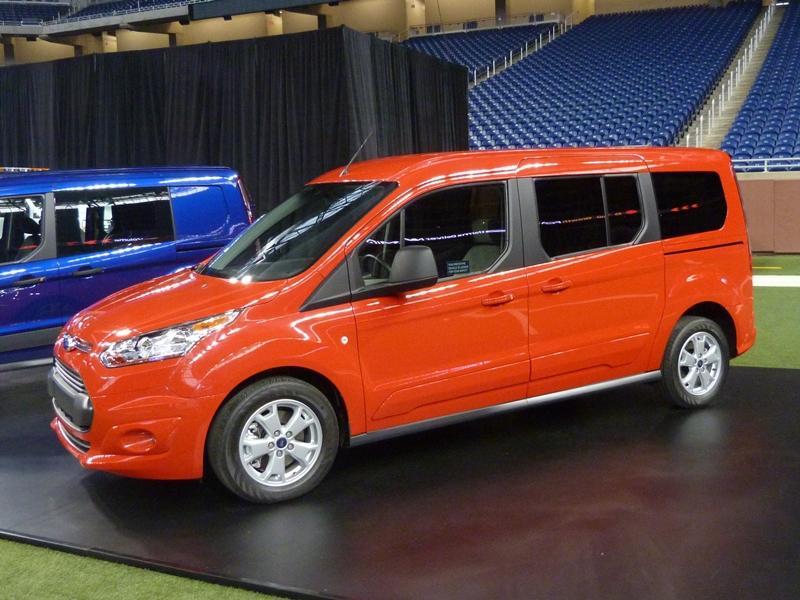 Over the years minivans have gotten larger and larger, to the point that they’re far from “mini.” If a more compact van were available, with more agile handling, better fuel economy, and a lower price, would people buy it? The Mazda5 hasn’t done especially well. But maybe the 2014 Ford Transit Connect, arriving later next year, will fare better. What do you think?
Over the years minivans have gotten larger and larger, to the point that they’re far from “mini.” If a more compact van were available, with more agile handling, better fuel economy, and a lower price, would people buy it? The Mazda5 hasn’t done especially well. But maybe the 2014 Ford Transit Connect, arriving later next year, will fare better. What do you think?
Ford started importing the Transit Connect a few years ago. It has been available in Europe since 2002. But the great majority have been bought and used as commercial vehicles. But, due to many changes made with the redesign, Ford expects the share of the “wagon” variant (with rear seats) to increase from 20 percent to 60 percent.
The new Transit Connect is certainly much more attractive, with more car-like styling and less tippy proportions. In long-wheelbase form (pictured) it looks better in person than it does in photos, if still very much (too much?) like a van. The short wheelbase version is 16 inches shorter, drops the third row, and looks stubby. With either I don’t care for the combination of the side windows’ beveled bottom corners and blacked-out pillars. If you’re going to black out the pillars, whey bevel those corners?
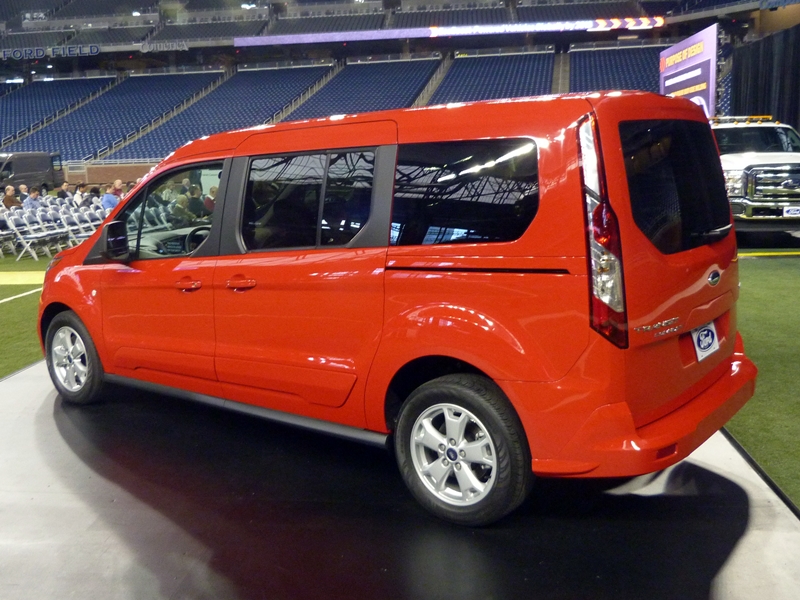 Compared to the current Transit Connect, the new one is nine inches longer (189.7″) and seven inches lower (72.0″). Width is up a little over an inch (72.2″), so the van is no longer taller than it is wide. Compared to the Mazda5, the upcoming Transit Connect is about nine inches longer, three inches wider, and eight inches taller–the Ford is much larger. But compared to a Honda Odyssey it’s thirteen inches less lengthy, seven inches narrower, and three inches taller–much smaller. There has been a huge gap between the Mazda5 and regular minivans. The Transit Connect fills this gap.
Compared to the current Transit Connect, the new one is nine inches longer (189.7″) and seven inches lower (72.0″). Width is up a little over an inch (72.2″), so the van is no longer taller than it is wide. Compared to the Mazda5, the upcoming Transit Connect is about nine inches longer, three inches wider, and eight inches taller–the Ford is much larger. But compared to a Honda Odyssey it’s thirteen inches less lengthy, seven inches narrower, and three inches taller–much smaller. There has been a huge gap between the Mazda5 and regular minivans. The Transit Connect fills this gap.
Inside, the new Transit Connect’s interior is much more thoroughly finished. Options will include leather upholstery and a panoramic sunroof. The materials in the prototype looked and felt much cheaper to me than those in side a Focus, but I was told that those in the production van will be much nicer. Ditto the unrefined sound and feel of the door when pulled shut and the overly firm, insufficiently padded commercial-grade seats.
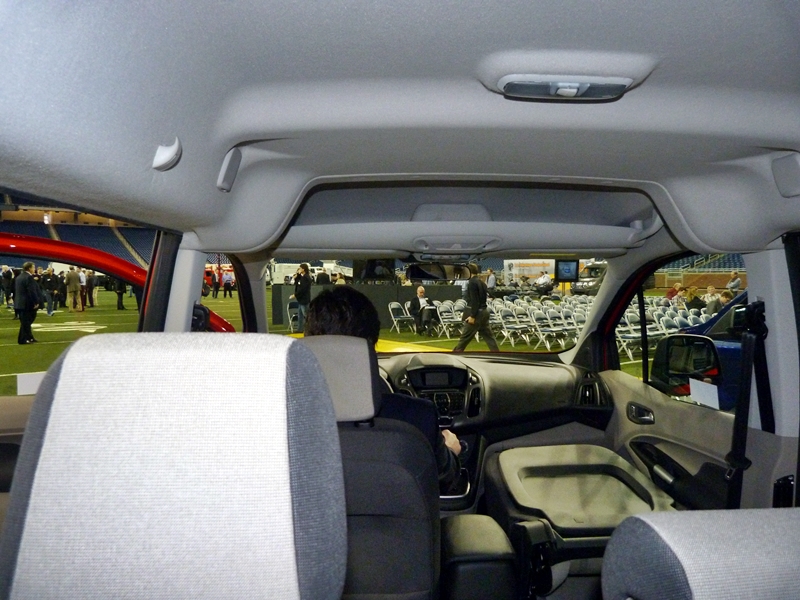 Even with the height reduction, there’s about five inches more headroom than in a roomy car, so much that there’s space for a standard storage area over the windshield and an optional one over the space between the first and second rows. The driver’s seat is a little low for my personal taste in its lowest position, but it can be raised substantially. The view forward is very open. There’s plenty of room in the second and even in the third row for adults. The problem with the third row isn’t a shortage of space–I could fit (if just barely) even with the seat all the way forward on its tracks–but the very low position of the very thin seat cushion. Adults have to sit knees-high. A shame, as the third row (unlike the second) also reclines.
Even with the height reduction, there’s about five inches more headroom than in a roomy car, so much that there’s space for a standard storage area over the windshield and an optional one over the space between the first and second rows. The driver’s seat is a little low for my personal taste in its lowest position, but it can be raised substantially. The view forward is very open. There’s plenty of room in the second and even in the third row for adults. The problem with the third row isn’t a shortage of space–I could fit (if just barely) even with the seat all the way forward on its tracks–but the very low position of the very thin seat cushion. Adults have to sit knees-high. A shame, as the third row (unlike the second) also reclines.
Though to a lesser degree than in the other two, I also had plenty of air between my head and the headliner in the third row. So why couldn’t they have positioned the cushion higher? Most likely to enable the seats to fold (through a complicated process) to form a very low, entirely flat load floor. The third seat cushion is very thin for the same reason. The front passenger seat also folds, but not nearly as low as the others. Total cargo volume behind the first row is just over 100 cubic feet, about three-quarters that in a large minivan but more than in all but the largest crossovers.
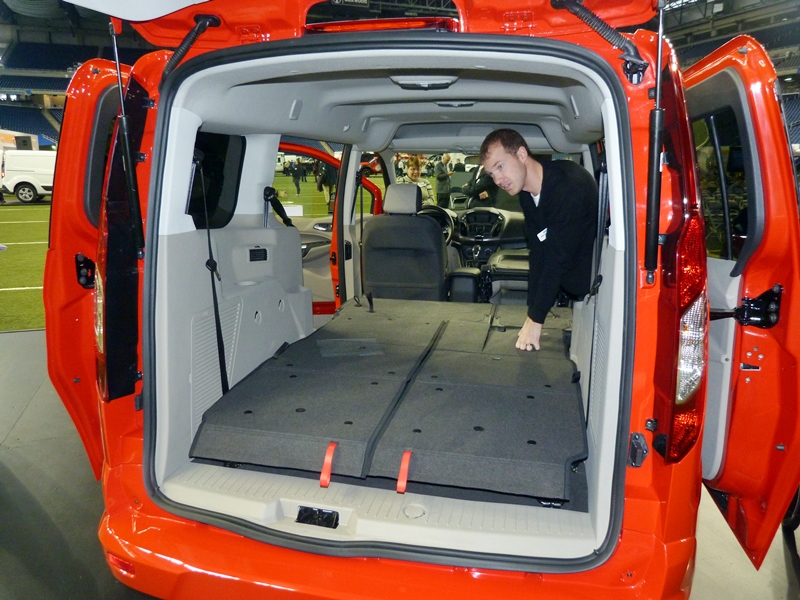 About that complicated process. The cushion of the second-row seat cushion pivots forward and then down into the second-row footwell, which is lower than the floor behind it. The second-row seat then folds down and locks on top of it, to form a surface just a few inches above the floor behind it. (The release for the lock broke when someone pulled on it especially hard. They probably couldn’t figure out why the seat wasn’t releasing with a lighter tug–that reason being that the second-row seat’s headrest gets stuck beneath the driver’s seat when the latter is far back.)
About that complicated process. The cushion of the second-row seat cushion pivots forward and then down into the second-row footwell, which is lower than the floor behind it. The second-row seat then folds down and locks on top of it, to form a surface just a few inches above the floor behind it. (The release for the lock broke when someone pulled on it especially hard. They probably couldn’t figure out why the seat wasn’t releasing with a lighter tug–that reason being that the second-row seat’s headrest gets stuck beneath the driver’s seat when the latter is far back.)
I could not personally figure out how to fold the third-row trick. The trick is that the seat’s cushion must first be pulled up uses a tab attached to its rear edge, then flopped through a 180-degree arc so that it is now upside down on top of the cargo floor. The third-row seat back then pivots and folds to occupy the space entirely behind the folded cushion. Since there’s no overlap between the two folded pieces, they only raise the load floor a few inches.
Finally, you unfold the cover attached to the third-row seat back and extend it to cover the gap between the folded seats. This cover is thin, but the floor it makes feels rigid. I should have asked about the maximum load…
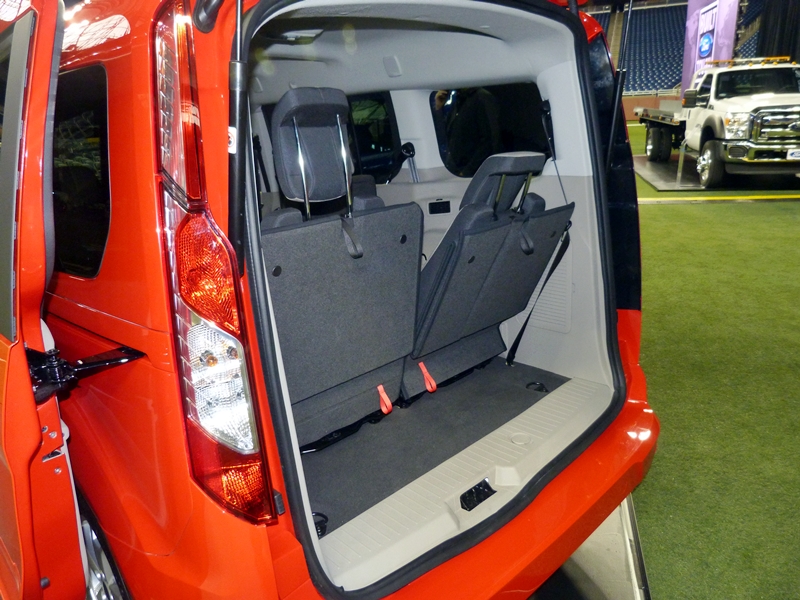 Luggage space behind the third row is a little tight if that seat is all the way back AND fully reclined. With the seat forward and upright there’s about as much cargo space back there as in my much larger Taurus X or other large crossover, if not as much as in a large minivan. Unlike in the Mazda5, I think my family AND our luggage would fit.
Luggage space behind the third row is a little tight if that seat is all the way back AND fully reclined. With the seat forward and upright there’s about as much cargo space back there as in my much larger Taurus X or other large crossover, if not as much as in a large minivan. Unlike in the Mazda5, I think my family AND our luggage would fit.
Performance and handling remain to be seen. The Focus and Escape are near the top of their respective segments in handling, so the new Transit Connect should do well here–unless its greater height and weight are too much for the common platform. Curb weight hasn’t been released, but the Transit Connect is considerably larger and thus probably also considerably heavier than the other two Fords. At the same time, no high-performance engine will be offered. In North America choices will be limited to a 168-horsepower 2.5-liter and a 177-horsepower turbocharged 1.6 liter. Both four cylinder engines provide adequate but far from exceptional performance in the less massive Fusion midsize sedan and Escape compact crossover.
Overall, I was impressed by the new Transit Connect. Its styling is much improved, and it has much more room inside than I expected. The seats are a complicated, but this does enable a low, flat floor. I would like to see a more nicely finished interior, a more solid feel to the doors, and a cushier feel to the seats. A Ford manager said these shortcomings will be addressed with the production version. When a production Transit Connect arrives later next year, we’ll see to what extent these issues are resolved. My guess based on past experience: part of the way, but not all of the way.
So, if you have/need a three-row vehicle, might you buy the new Transit Connect? Why or why not?